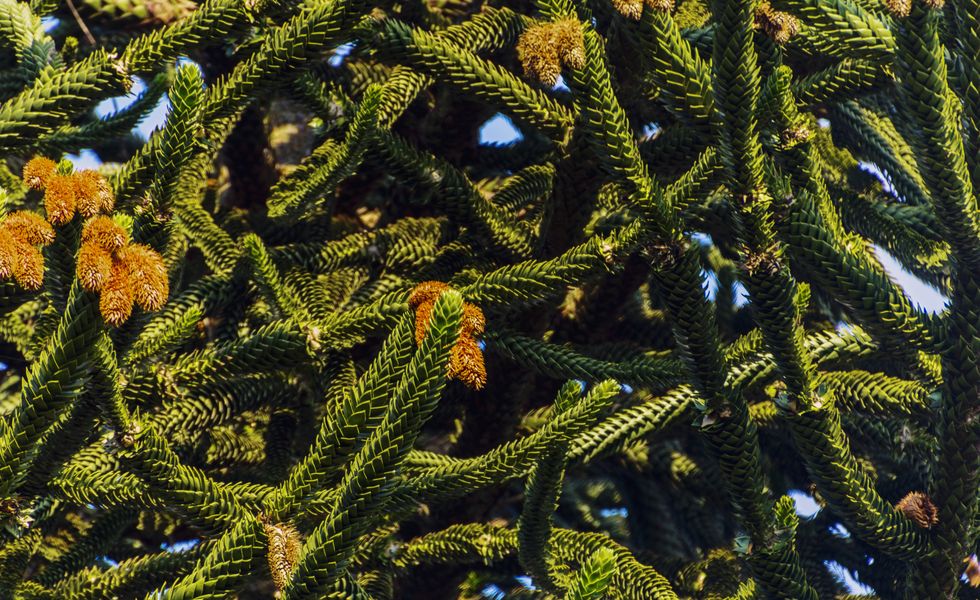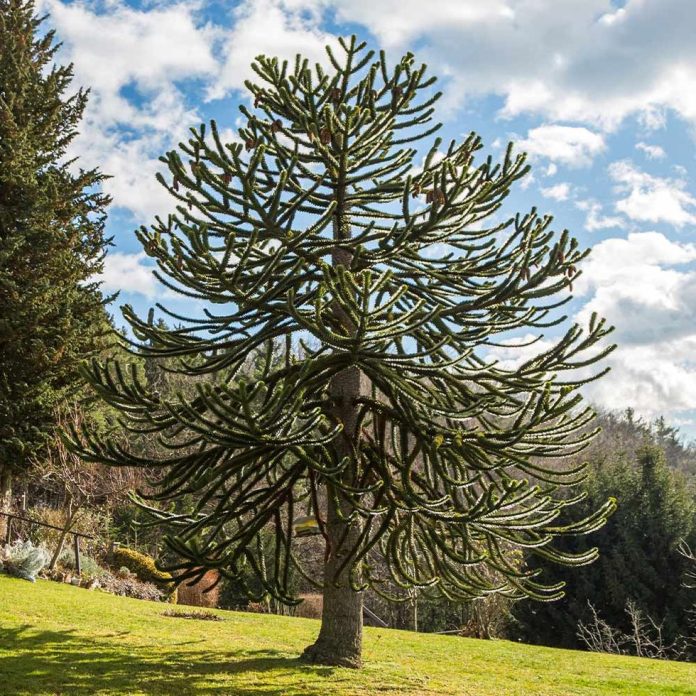One of nature’s most unique plants, the monkey puzzle tree (also known as araucaria araucana) is a bit of a mystery. Due to their unusual, thorny branches, it’s a great option for plant lovers looking to add a dose of flair to their space.
“There isn’t a tree out there like the monkey puzzle, especially compared to native choices within the United States,” says Tamara Hogan, resident plant expert at Fast Growing Trees, an online nursery. “Its blade-like leaves and branch structure are unlike any other conifer trees. It’s also an evergreen that can handle some cooler, humid environments since the southern areas of Chile is where this tree comes from.”
Another benefit of growing one? You can live with a monkey puzzle tree for a long time. It can grow up to 90 feet tall and survive for thousands of years if it isn’t cut down. However, since a monkey puzzle tree is so rare, many people aren’t sure how to make one thrive indoors or outdoors. To help you out, we’ve consulted with experts at Fast Growing Trees to share everything you need to know about caring for a monkey puzzle tree.
How to Care for a Monkey Puzzle Tree Outdoors
- Give it plenty of sunlight. Ideally, you’ll want to plant your tree so that it’ll receive full or partial sunlight to keep it happy. Fast Growing Trees recommends three to six hours of light every day. If you live in a climate with scorching summers, plant it in a spot where it’ll get extra shade.
- Water your tree well. Find an area with well-drained soil and water your tree every one to two weeks. Adding a two- to three-inch layer of mulch at the base will help protect it as well.
- Fertilize once a month. Aim to fertilize your monkey puzzle tree once a month during the early spring and summer. If it’s overfertilized, its roots can become damaged.
- Prune it every spring. Remove any low-growing, dead or broken branches in the early spring to keep your tree happy.

Fast Growing Trees
How to Care for a Monkey Puzzle Tree Indoors
- Give it plenty of sunlight. One of the biggest challenges to growing a monkey puzzle tree indoors is the lack of light it’ll receive if you live in a place with cold winters. And if you live in an urban area, you’ll likely need full spectrum lights to give it proper care.
- Allow the soil to drain. Your indoor plant will do best if you water it about every two days and allow the soil to throughly drain, according to Hogan. If the air in your apartment is dry, Hogan also suggests using a basic humidifier.
- Keep an eye on its growth. Eventually, your monkey puzzle will grow very tall, so although you’re naturally slowing down its growth by planting it in a pot, it’s important to note that these trees are not made to live indoors permanently.
Common Problems to Consider
Since monkey puzzle trees can grow up to 90 feet tall, they can be a very messy plant for a backyard. If you plant one in the wrong spot, the roots can cause damage to everything from sidewalks to driveways. Keep in mind that they should be kept away from power lines, too. It’s recommended to leave about 24 feet of space around it when planting. And once the tree fully matures, it’ll litter the yard with cones that can hurt your feet if you happen to step on them.

Piero M. Bianchi//Getty Images
Common Pests and Diseases
While this tree is hardy and has good protection against pests, mealy bugs, spider mites, thrips and scale might creep up on them. These issues can be easily fixed with horticultural oil. Root rot, leaf spots and sooty mold are also rare diseases for this tree but they do happen, and can be easily treated with fungicide. Ensuring that the soil is well-drained will prevent root rot from killing your tree.
Where does the monkey puzzle tree get its name?
The name came about in the mid-1800s, when barrister Charles Austin commented that it’d be “puzzling” for monkeys to climb this tree because of its sharp needles and branches.
What is the ideal environment for a monkey puzzle tree?
Monkey puzzle trees do best in temperate climates with cool and moist conditions. They will thrive in regions with mild summers and cool, wet winters. While these trees can tolerate some cold temperatures, longtime exposure to below-freezing temperatures can harm them. Feel free to check the USDA Plant Hardiness Zone Map — zones 7 – 10 in the U.S. are ideal for monkey puzzle trees.
Are monkey puzzle trees known to resist deer?
Deer tend to leave this particular tree alone, but don’t be surprised if they happen to be curious out of extreme hunger.
Are monkey puzzle trees an endangered species?
Monkey puzzle trees are very rare and currently only grow in the Andes Mountains in Argentina and Chile. While they once grew across Africa, India, South America and Australia, their numbers have dwindled because of human interference and they are now protected.
Cailey Lindberg (she/her) is a writer and editor with over a decade of experience covering products, lifestyle, entertainment and food. Before joining Good Housekeeping in 2022, she was a staff writer at USA Today’s shopping network, Reviewed.com.
www.goodhousekeeping.com
https://www.goodhousekeeping.com/home/gardening/a45375784/how-to-grow-monkey-puzzle-tree/















